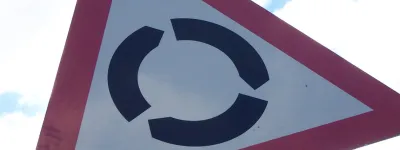Following the acceptance of the Anderson Committee's report, the Ministry of Transport appointed the Adams Committee to adapt the design of the signs for use on dual carriageway non-motorway roads. These included new diagrams for at-grade junctions and other off-motorway hazards, and used white text on a dark green background (including for plates underneath warning signs). By the time these were produced and in use, it was known that the Worboys Committee would produce new specifications for traffic signs in the near future and they were only intended as a temporary solution. Nonetheless they were used successfully on a number of roads, including the Stamford Bypass. The Committee ended up using the white-on-green colours of these signs for primary routes.
Worboys drafts
In arriving at their final set of designs, the Worboys Committee considered a wide range of ideas. As well as examining the standard European designs and the protocols of the Vienna Convention (which established international standards in traffic signs), the Committee came up with a number of ideas of its own.
For example, images exist of some of the experimental signs that were erected. One shows that italicised route numbers on B-roads were under consideration. Others show that for a time the Committee wanted to add diagonal bars across many signs that the Vienna Convention left open - such as "no pedestrians", "no cyclists", and very oddly, "no overtaking".
While the Committee eventually agreed that local direction signs would retain the blue border they gained in the 1955 regulations, a proposal that appeared concrete at draft stage but which did not make the final report was to have minor road signing in urban areas in black on yellow - this was so serious for a time that numerous test signs were erected across London.
Some of the ideas above were removed from the draft so late that they were reported in some places as features of the new traffic sign system.
